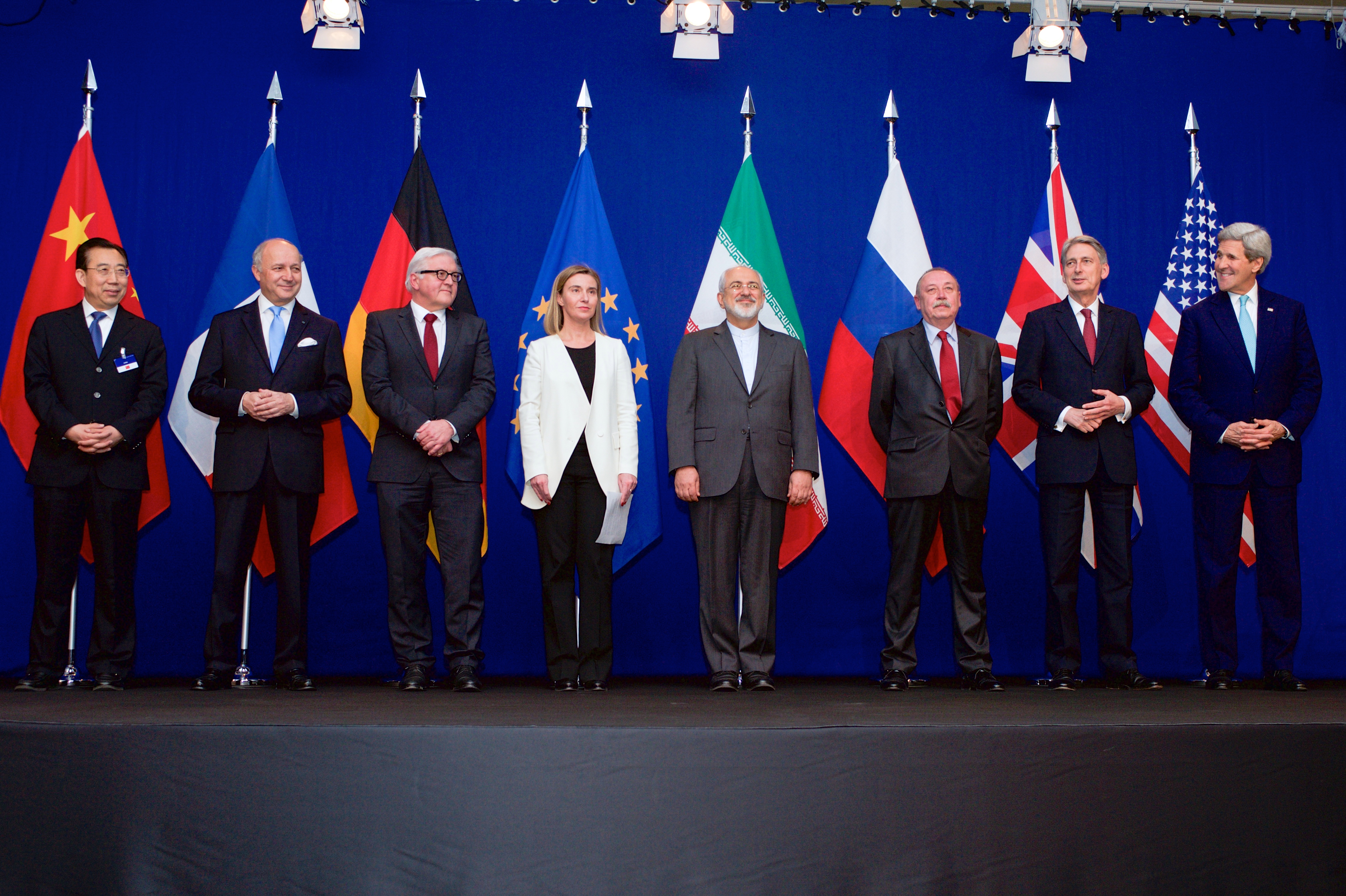By: Josepha Laroche
Translation: Lawrence Myers
Passage au crible n°100
 Source : Wikipedia
Source : Wikipedia
After ten years of successive failures, a temporary accord on the Iranian nuclear program was signed in Geneva on November 24, 2013, between Iran – by Mohammed Javad Zarif – and the representatives of the group 5+1, namely the five permanent members of the Security Council (China, the United States, France, the United Kingdom, Russia) and Germany. This document predicts a renewable period of six months before final negotiations will be undertaken. For the moment, the participating parties have agreed on a substantial deceleration of the Iranian nuclear program. It has therefore been established that its uranium enrichment cannot exceed 5%, and this in order to distance the spectrum of a military nuclear program. As for the existing stock of uranium already – enriched to 20% near the military level – it will have to be neutralized. Lastly, the planned new centrifuges must remain non-operational. Similarly, it will be necessary to stop the work in progress relative to heavy water. In return for this series of obligations, Iran will obtain a partial lifting of the sanctions that until now have been weighing it down. For example, the country will be able to access previously inaccessible funds, which reached 4 billion dollars. However, the essential aspects of the embargo measures remain in place, in particular those concerning the exportation of oil and financial transfers from Iran. It is certain that this conversation constitutes a first step towards the appeasing of tensions, but it remains entirely reversible.
> Historical background
> Theoretical framework
> Analysis
> References
The NPT (Treaty of Non-Proliferation of Nuclear Weapons), signed July 1, 1968, came into force on March 5, 1970, after the ratification by the depository states (the United States of America, the United Kingdom, the USSR and forty other signatories, including Iran, which signed and ratified the treaty in 1970). It rested on the established distinction between NWS (Nuclear Weapons States) and non-NWS (Non-Nuclear Weapons States). It established that the former (USA, USSR, UK) were committing not to help another country acquire nuclear weapons. As for the non-NWS, they were renouncing their aim to create and to try to obtain them. On the other hand, the NWS (called “the nuclear club”) guaranteed the non-NWS an ease of access to civil nuclear capabilities, on a basis of non-discrimination (articles IV and V). In other words, these measures, which principally target the reduction, even the containment, of horizontal proliferation, that is to say, the extension of nuclear armament in the world, are still in effect.
Since then, in virtue of article III of the NPT, the IAEA (the International Atomic Energy Agency) upholds its mission to monitor the peaceful use of nuclear matter by non-NWS countries. In order to do this, it has signed guarantee agreements with each one of them so that it can verify that the parties are respecting their engagements. A reinforcement program of the IAEA guarantees, called “93+2” was then put into place to expand the reach and the precision of these inspections; the objective being to guarantee a better efficiency of the non-proliferation regime.
Still part of the NPT today, Iran must therefore submit itself to all requirements for verification of the IAEA’s authority in its nuclear program. However, the Agency suspects that Iran has been engaging in secret operations in order develop nuclear arms for the last ten years. Since that time, the negotiations have multiplied, soon followed by a flood of sanctions whose termination is a currently a pressing subject.
1. The civilizational scope of the sanctions. Constitutive elements of international public law, the sanctions belong to the repressive arsenal put into place by States over the last few centuries. Their intention is to avoid wars by condemning to contrition every aggressive actor that might attempt to violate international rules. Thus, by efficiently bringing about a diplomatic framework for war violence, state actors endeavor to civilize their interventions.
2. The dissuasive limits of coercive diplomacy. Less well determined than military strategy, this coercive diplomacy remains nonetheless a delicate maneuver. Of course, it aims to sway negotiations in the required direction, all the while avoiding the human and material cost of a classic conflict. But it necessarily implies the acceptance of a zone of uncertainty, inherent to the games of strategic interaction between the actors present. Yet, this zone abandoned to hazard is denounced and refused by Israel who claims that Iran is simply exploiting this model.
In 2003, the IAEA announced the Iranian site in Natanz indicated levels of enriched uranium that exceeded civil standards. Therefore, the Agency asked Iran to prove that it was not developing a nuclear weapon. Since that time, Tehran and the States concerned with the respect of the NPT have been engaging in an increasingly tough power struggle. Due to a lack of progress, the IAEA transmitted the dossier of the Iranian nuclear program to the UN Security Council in 2006. The Council sanctioned Iran by voting for resolution 1737, which prohibits the sale of all material or technology able to contribute to Iran’s nuclear or ballistic activity. Additionally, this text imposed an ultimatum on the country. In 2007, the Council adopted new economic measures (resolution 1747) aiming to strike the uranium enrichment program in Natanz. As for the United States, they have taken repressive measures, directed against the 3 principal Iranian banks. Finally, in 2008, the UN adopted new economic and trade restrictions. Beginning in 2009, the IAEA multiplied alarmist reports, while Iran was launching the first factory for the production of nuclear fuel in Isfahan, even announcing that it had installed 7,000 centrifuges. Otherwise, the country admits to having a uranium enrichment plant near Qom. In 2010, while a 4th coercive wave was being voted for, the IAEA evoked “serious concerns regarding a possible military dimension of the nuclear program”, this drove the United States and the European Union to also stifle the entire Iranian banking sector. The decisions made against it concern the energy sector, foreign holdings, the automobile industry, transportation and commerce in general. Besides that, the West prohibits more than 3,000 Iranians from traveling abroad. To enforce respect of the NPT, while also avoiding a conflagration, which in turn could ignite the entire region, this embargo has built up an economic stranglehold over time, which heavily burdens the development of the country without regulating the dispute. In these conditions, many observers consider that the signature on November 24, 2013, contributes to appease tensions and reinforce global security.
On the other hand, for Israel, according to Prime Minister Benjamin Netanyahu, this agreement “is an historic error”. It is allegedly not credible and simply corresponds to a clever policy of procrastination and whose terms permit Iran to continue more or less secretly in its enrichment of uranium for military purposes. As a result, Israeli leaders are harshly criticizing the softening of sanctions, continuing to maintain their right “to defend ourselves […] against all threats”. Jerusalem, not bound by this concession, intends to maintain the option of military strikes. If in the short term it proves to be obsolete, this scenario could, however, be on the agenda in six months. Indeed, if a definitive accord were not concluded, the principle uncertainty would unite all stakeholders involved in this affair detrimental to world peace.
Davis Jacquelyn K., Pfaltzgraff Robert L., Anticipating a Nuclear Iran: Challenges for U.S. Security, New York, Columbia University Press, 2013.
Elias Norbert, La Civilisation des mœurs, [1939], trad., Paris, Calmann-Lévy, 1973.
Elias Norbert, La Dynamique de l’Occident, trad., Paris, 1975.
Laroche Josepha, La Brutalisation du monde, du retrait des États à la décivilisation, Montréal, Liber, 2012.
Lindemann Thomas, Sauver la face, sauver la paix, sociologie constructiviste des crises internationales, Paris, L’Harmattan, 2010. Coll. Chaos International.
Tertrais Bruno, Iran : la prochaine guerre, Paris, Le Cherche-midi, 2012.




